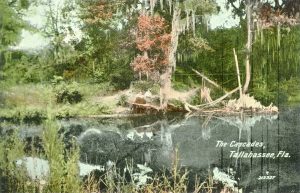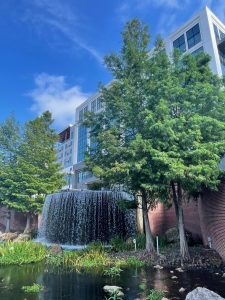
In the early 1800’s, the Spanish divided us into East and West Florida. St. Augustine was the capital of East Florida, while Pensacola was the capital of West Florida. The peninsula was Seminole territory, and very few European settlers ventured south. When the United States acquired the Florida territory, they retained the dual capitals, with government meetings held alternatively in each city. Eventually, representatives from both cities grew tired of traveling so far and decided to create a new capital city halfway between them. That location, 3 hours from each coast, landed in Tallahassee. In particular, they met and camped at a beautiful spot known as the Cascades, which had a running stream and a waterfall that dropped into a sinkhole. In 1824, they built a log cabin at the site to hold official meetings.

As the city grew and changed, the lovely little creek and waterfall were swallowed by development and pollution. A manufactured gas plant operated on the site between 1890 and 1950, discharging hazardous waste into the soil and groundwater. By the 1920’s, the city also co-located a landfill at the site, contributing even more pollution. Eventually, the EPA recognized the serious water quality problems at the Cascades and designated it as a Superfund site. They began taking enforcement action, requiring a response from the city to start a cleanup.
Thankfully, by the early 2000’s, some innovative leaders working under a locally government partnership called “Blueprint 2000” decided not only to clean up the site but return it as closely as possible to its original beauty. By 2006, they had removed 85,000 tons of contaminated soil and were even given an award of excellence by the EPA for going above and beyond cleanup requirements. Between 2010-2014, they constructed Cascades Park, a joint city/county effort to restore the once-peaceful watery oasis in the middle of town.

Today, Cascades Park consists of a 24-acre pond, a run of restored flowing stream, a recreated waterfall, and a landscaped perimeter full of healthy wetland vegetation. The pond treats stormwater from the surrounding city and takes on excess floodwater during heavy rains. There is a 2-mile walking trail around the pond, along with a children’s playground and an amphitheater.
The city also incorporated numerous historic monuments and signage in the park and surrounding areas, tying in local history and culture with environmental improvements. A historic African-American community, Smokey Hollow, is commemorated with signage and “spirit houses” that evoke the shotgun houses and residents who lived there until the 1960’s. The park has a Korean War memorial and a marker for the Prime Meridian of the state, from which all property townships are measured. The Cascades are also the historic location of Centennial Park, built in 1924, which was home to decades of high school graduations, minor league baseball, and even Florida State University’s first three seasons of football games. As we speak, a replica of the original capitol building log cabin is being built in the park to commemorate the 200th anniversary of the move to Tallahassee as the capital.

Besides the obvious environmental improvements, Cascades Park has been an economic driver. The old city gas plant building has been transformed into the trendy Edison restaurant, with a café called The Power Plant downstairs with decks overlooking the water. There are numerous office buildings and apartment complexes (one called The Cascades!) built adjacent to the park and offering window/balcony views of the waterway. What was once a scourge to be avoided has become an amenity and improved the quality of life for residents of Tallahassee.
Locally, we have several remediated brownfields, Superfund sites, and formerly flooded areas that have been turned into parks and stormwater management areas. These multi-functional areas are aesthetically pleasing and provide benefits to both people and the wider ecosystem. Creative, cooperative projects like this give us excellent examples of successful ways to tackle the problems of our day, and serve as reminders that what seems insurmountable can be overcome with vision and dedication.
 11
11
